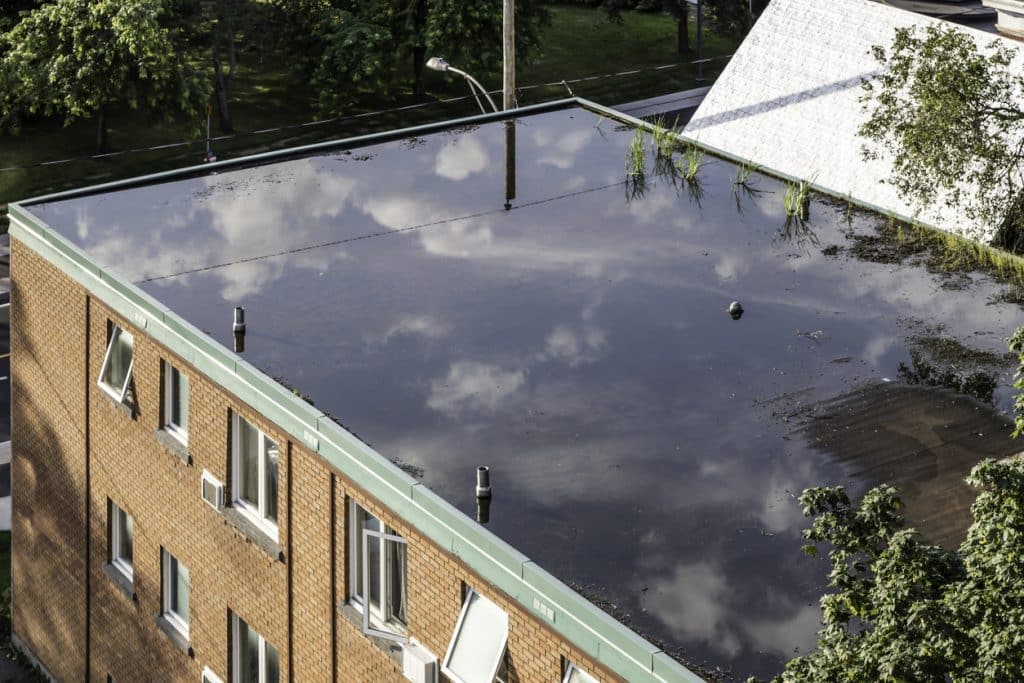
Flat roof drainage is critical for your property. With Calgary’s deep snow and rain, flat roof drainage keeps roofs lasting.
Correct solutions, such as interior drains, scuppers, or tapered insulation, guarantee water is funneled away efficiently, minimizing chances of leaks or structural problems.
That’s why, at Angel’s Roofing, we customize flat roof drainage systems to suit Calgary’s specific seasonal requirements.
Why Drainage Matters
Flat roofs, which are common in both residential and commercial buildings, need to have efficient drainage systems to avoid problems caused by water pooling. Without drainage, water pooling on flat roofs can cause structural, material and financial headaches, especially here in Calgary, where heavy rainfall and snow is common.
1. Structural Integrity
Pooled water beyond 48 hours can compromise roofing materials and lead to sagging. Flat roofs, which usually have a slope of around 1/4 inch per foot, depend on good drainage. Stagnant water encourages cracks and material breakdown, weakening the roof even more.
These problems are compounded by clogged drains or gutters, which can lead to leaks and structural failures. In winter, bad drainage causes ice dams, which bring extra weight and compromise a roof’s snow load capacity.
2. Roof Lifespan
Drainage is very important to the life of a flat roof. Water is what ages a roof prematurely. For example, water can cause membrane blistering or separation from its substrate.
Fixing drainage problems before they become a costly replacement protects the durability of the roof during Calgary’s unpredictable freeze-thaw cycles. Regular inspections and maintenance, like removing drain debris, play a major role in prolonging roof life.
3. Interior Protection
Water under a leaky roof can ruin ceilings, walls and insulation. This is a breeding ground for mold, endangering the quality of indoor air and the safety of its inhabitants.
Calgary businesses stand to lose precious equipment or face downtime because of water damage. Well-planned drainage protects interiors and preserves a healthy indoor environment.
4. Foundation Safety
Poor drainage means water may get into the foundation and cause erosion or basement flooding. This undermines building stability and raises repair costs.
Redirecting water away from the foundation is key to protecting structural integrity.
Calgary’s Unique Challenges
Flat roofs here in Calgary deal with some special drainage issues because of our crazy, unpredictable climate. With temperature fluctuations that fluctuate from -40C to +40C, heavy snowfalls, quick thaws and hailstorms, drainage needs to be designed and maintained properly to avoid water infiltration and leaks. A proactive approach is key to keeping these roofs running all year long.
Heavy Snowfall
Calgary’s deep winters tend to blanket us in heavy snow on flat roofs. Drainage systems must be able to withstand the weight of snow to prevent roof sagging or collapse. Snowmelt must be able to drain effectively through correctly positioned roof drains and scuppers to prevent pooling that may cause leaking.
Tapered insulation to direct the water flow as well is equally important. Good insulation keeps snow from building up – it doesn’t melt – because the heat is not leaking away, so the roof can hold snow for days and weeks.
Rapid Thaws
Calgary spring tends to result in quick snow melt as the temperatures swing wildly. That sudden runoff can swamp drainage systems if not engineered to handle it. Overflow drains are essential to expel excess water and prevent pooling during freeze-thaw cycles.
Simple upkeep — nothing more than removing detritus from gutters and drains — guarantees water passage. Spring and fall inspections, twice a year, can go a long way to catching and fixing problems early.
Ice Damming
Ice dams occur when heat leaks from a roof, melting snow that then refreezes at the eaves. In Calgary’s environment, ensuring a good roof slope and drainage design is crucial to avoid this problem. The roof should be insulated to minimize heat loss and you can install heating cables to control ice buildup.
Clearing snow and ice on a daily basis from roof edges reduces blockages.
Hail Impact
Calgary’s frequent hailstorms, for example, wreak havoc on drainage components, including gutters and scuppers. By utilizing impact-resistant materials, you can be confident that your home will continue to do its job during and after these storms.
Post-storm inspections are key to catching and repairing damaged drainage components before it’s too late.
Common Drainage Systems
Flat roofs have to have good drainage systems or else you get water pooling and damage to the structure and leaks. Both drainage options have their advantages and disadvantages, so it’s important to choose the right one for your situation.
Interior Drains
For example, interior drains employ hidden piping to convey water from the roof to subterranean drainage. They are very useful in a colder climate such as Calgary where freezing temperatures can burst pipes outside.
By diverting water away from the building’s face, they help prevent damage to the exterior. These systems require ongoing upkeep to prevent clogging from debris accumulation, which can cause water to pool.
Scuppers
Scuppers are parapet wall openings that drain water off the roof. They’re inexpensive, low maintenance and frequently make the building look better.
Scuppers may be coupled with gutters or downspouts to direct water flow. In regions of heavy rain or snow, extra overflow drains might be needed.
Gutters
Gutters gather and direct water away from the building’s foundation. They’re simple to configure and great for smaller flat roofs.
These should be cleaned routinely to avoid leafi/ice/debris clogs. Gutters are susceptible to ice damage and heavy snow in Calgary’s climate, so they must be installed and monitored properly.
Siphonic Systems
Siphonic systems employ sealed pipes to generate a vacuum that drains water at a high rate. This is perfect on large commercial roofs of over 150m², because they’re able to move water up to 100 times faster than gravity systems.
These systems minimize the need for multiple drains, simplifying the roof design. It requires professional installation and periodic inspections to ensure performance.
| System | Benefits | Limitations |
| Interior Drains | Efficient, freeze-resistant | High maintenance required |
| Scuppers | Cost-effective, aesthetic | Limited for heavy rain without overflow drains |
| Gutters | Customizable, foundation protection | Clog-prone, weather damage risk |
| Siphonic Systems | Rapid drainage for large roofs | Requires professional setup, periodic inspections |
Signs of Poor Drainage
Drainage is key to flat roofs, as they are susceptible to long-term damage and expensive repairs if proper drainage isn’t taken into account. If you care about your property, it’s important to watch for the warning signs of poor drainage. Here are clues for the signs of poor drainage and how to defend your building.
Water Ponding
Water standing on a flat roof more than 48 hours after rain is a sure indicator of drainage problems. This is called ponding and it can cause structural stress, leaks, and sagging if left for an extended period. Look for obvious pools of water, particularly in spots without enough pitch.
Bowing or sagging spots on the roof typically indicate excessive water retention. To correct ponding, make sure the roof pitch enables optimal runoff. Think about adding some extra drains or scuppers.
In Calgary’s winters, ice dams from standing water can add even more weight to emphasize the urgency of the matter.
Leaks & Stains
Water stains on ceilings or walls are indoor red flags of a leaky roof. On the outer side, cracks or punctures in the roofing membrane can leak water. If left unchecked, leaks can cause mold and widespread interior damage.
Seal leaks promptly with expert repairs, and add waterproof coatings to strengthen your roof’s defenses against future water intrusion. Regular check-ups will catch them early, which is key during Calgary’s freeze-thaw cycles.
Plant Growth
Vegetation on flat roofs is not just unsightly but ruinous. Plant roots can get under roofing, and moisture held under debris promotes growth. Take out plants and scavenge leaves and seeds to avoid clogged drains!
Good drainage prevents water stagnation, reducing the likelihood of mildew and damage.
Damaged Materials
Check roofing materials for indications of water wear–blisters, cracks or grey crusts. If you find damaged membranes, flashing or shingles — replace them immediately.
By using durable, water-resistant materials you make sure the roof stands the test of Calgary’s tough weather.
Proactive System Maintenance
Flat roofs in Calgary require routine, proactive system maintenance to cope with the area’s unpredictable weather. A quality drainage system can help avoid water damage and prolong the life of your roof. Routine inspections, debris removal and system checks are instrumental in keeping it running at top gear all year long.
Regular Inspections
Regular inspections are an essential part of avoiding expensive drainage problems. During these inspections, look for clogs, leaks and physical damage – especially following severe weather. Be especially vigilant about gutters, scuppers, and downspouts — places that are likely to become blocked.
Documenting findings is equally important, as it not only creates records for future reference but helps track recurring problems over time. Twice a year is the inspection schedule we recommend, plus after storms or heavy snow.
Debris Removal
Leaves, dirt and debris can very quickly clog up the drainage system. Seasonal cleaning is most needed in the fall, when debris is at its worst. Be sure to clean gutters, scuppers and drains to avoid water pooling or overflowing and potentially damaging the roof.
If you’re not ready to upgrade, at least get gutter guards to lessen the amount of debris, which means less cleanings. Adding debris removal to your schedule will keep it draining and cause less wear on the system.
Component Checks
Checking the in-situ drains is another important measure. Inspect drains, pipes, and gutters for cracks, wear, or loose connections. Swap out broken pieces straight away.
Testing the system with water flow checks to make sure it’s working properly, preventing any unpleasant surprises. When tendencies are addressed proactively, even small repairs can make a big difference to long-term performance.
Future-Proofing Your Roof
Flat roofs must be designed future-proof your roof. By embracing innovation, sustainability, and advanced materials, property owners can both address drainage challenges and future-proof for Calgary’s changing climate.
Smart Sensors
Smart sensors that are transforming flat roof drainage. These monitor water levels and can sense pooling or clogs before they pose a serious problem. Real-time alerts assist property owners in acting quickly, staving off water damage that could compromise structural integrity.
For bigger buildings, pairing sensors with a building management system simplifies upkeep, providing one location to monitor drainage efficiency. Historical data collected by sensors can guide maintenance schedules to clean out gutters and drains before trouble ever begins.
Sustainable Options
Green drainage solutions are catching on. Materials such as recycled plastics or metals are not only eco-friendly but they’re long-wearing. Rainwater harvesting systems are another green option, collecting runoff for irrigation or non-potable applications.
Green roofs, where vegetation is paired with high-performance drainage layers, optimize water handling and increase insulation. These are a great choice in Calgary — where temperature swings require quick thermal responses. By choosing recyclable materials for drainage pieces, you’re future-proofing your roof.
Material Innovations
Innovations in roofing materials are changing the game for flat roof water management. High-performance membranes with superior water resistance reduce your chance of leaks and ponding. Durability-enhancing coatings minimize repair frequency, so they really do pay for themselves in the long run.
Lightweight drain components ease installation and strain on the roof. By keeping abreast of advances in materials, property owners are able to leverage the cutting edge of drainage and weather resistance.
Conclusion
Good flat roof drainages is essential for safeguarding your home in Calgary’s unpredictable weather. From heavy snow to sudden showers, a healthy system protects your roof and keeps your building dry. By prioritizing dependable drainage systems and maintenance, you prevent expensive damage and increase the longevity of your roof. With decades of experience behind us, Angel’s Roofing provides customized solutions that deliver for Calgary’s distinct climate.
If you’re ready to spruce up or service your flat roof drainage, contact us today. We’re here to assist with expert guidance and best-in-class support. Visit our About page to discover why we’re trusted by the community to provide quality and safe choices. Let’s maintain your roof’s peak performance!





